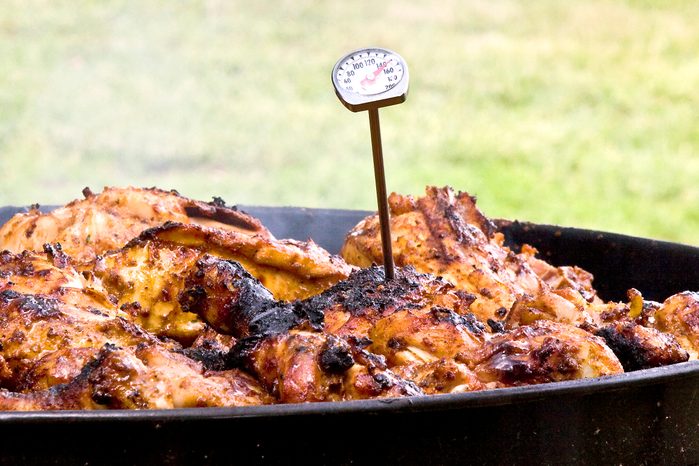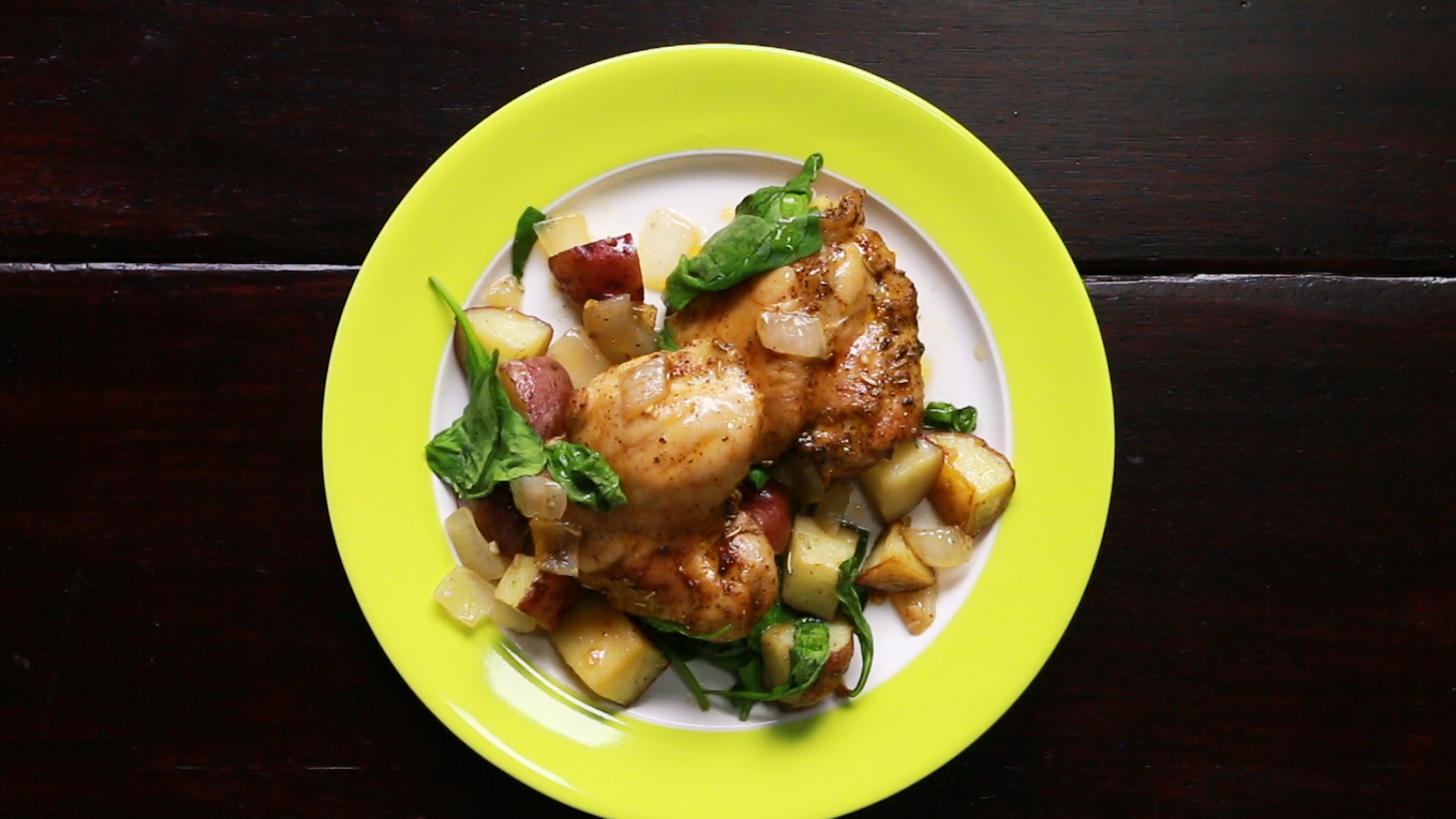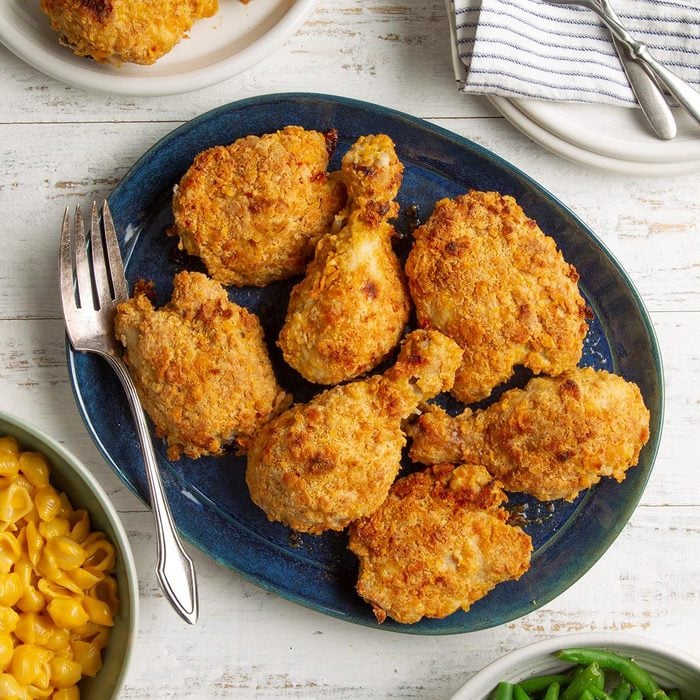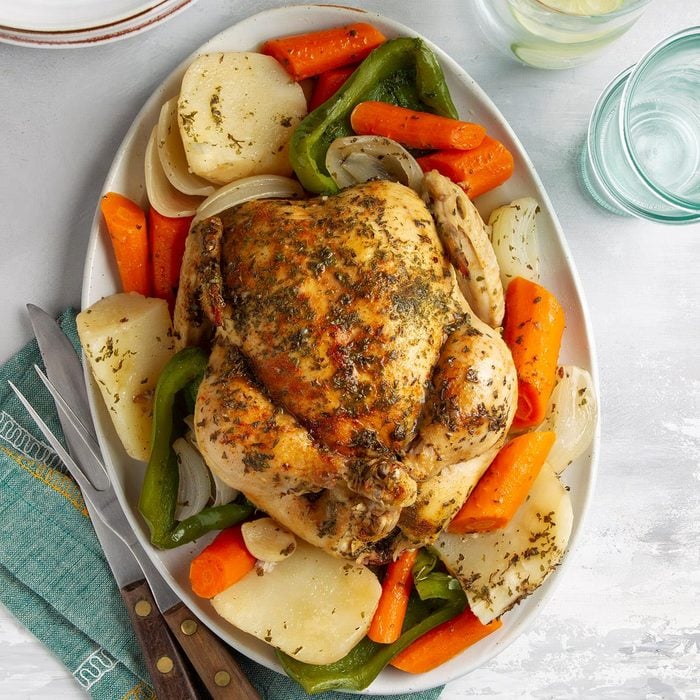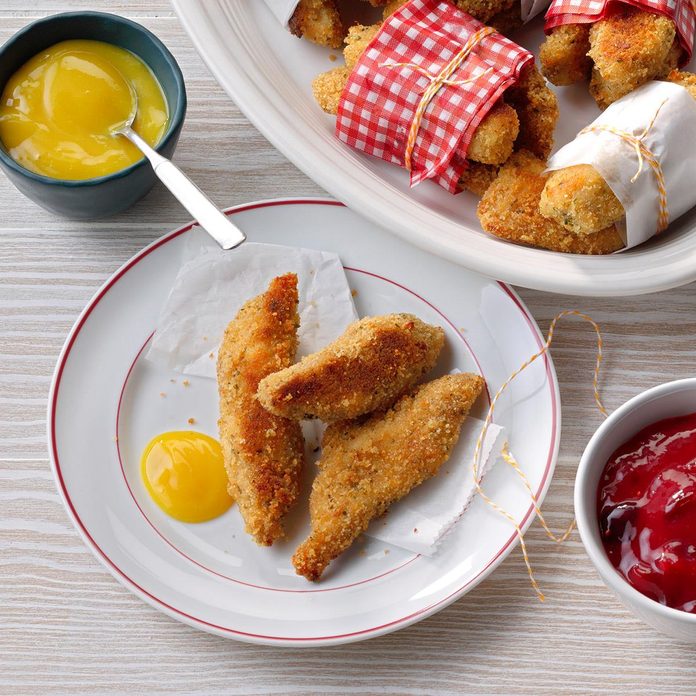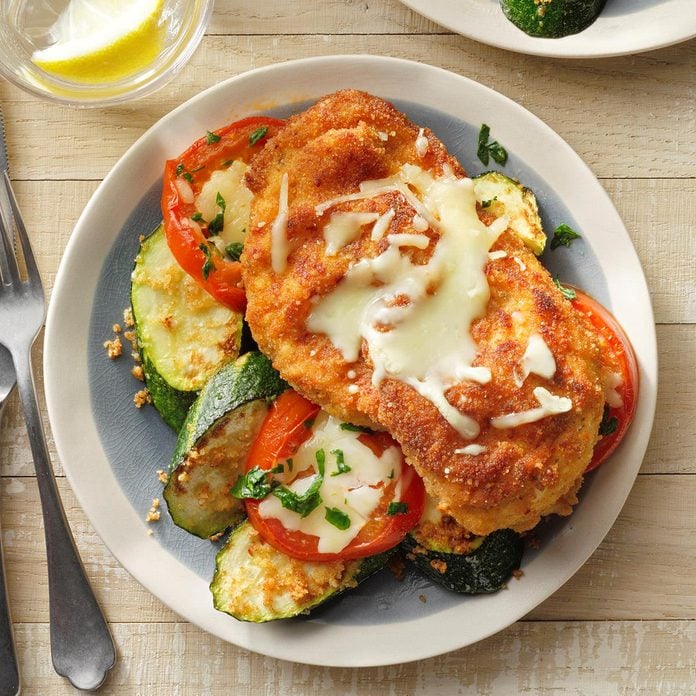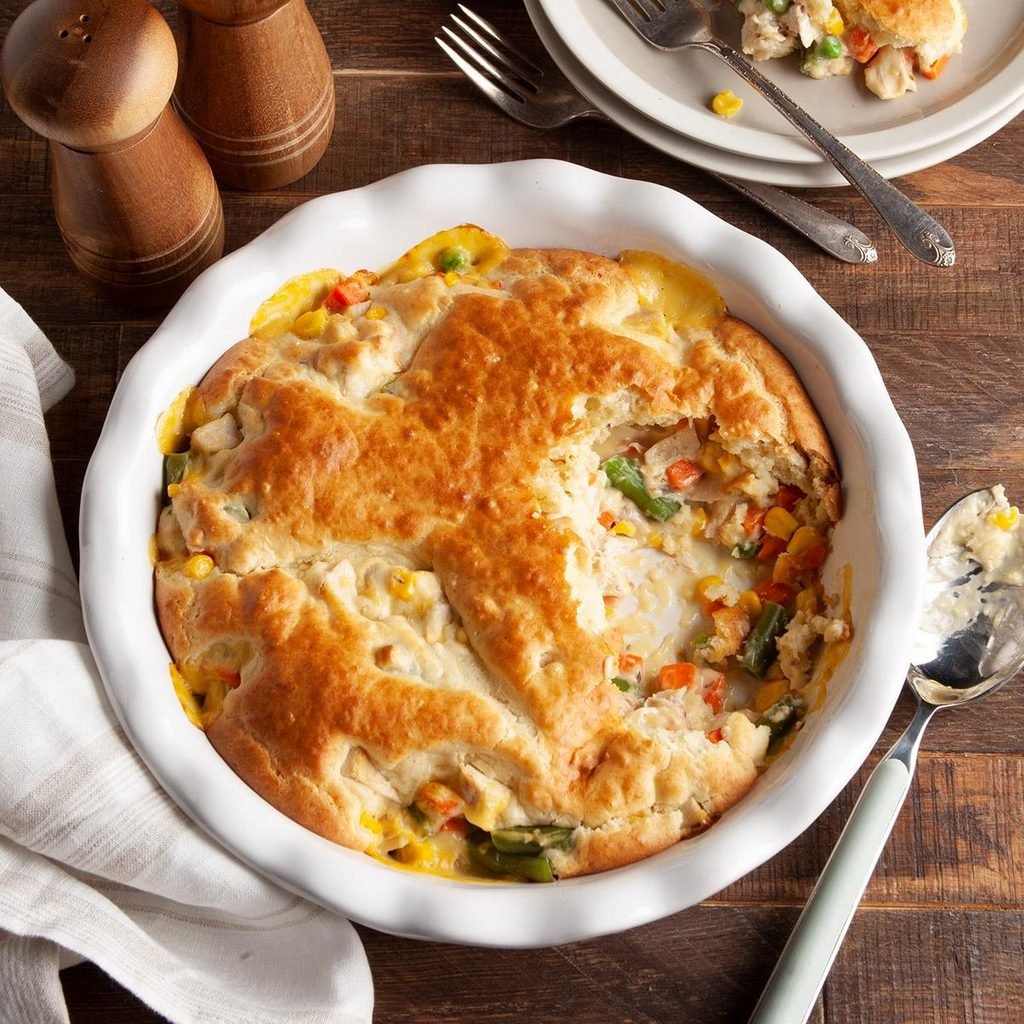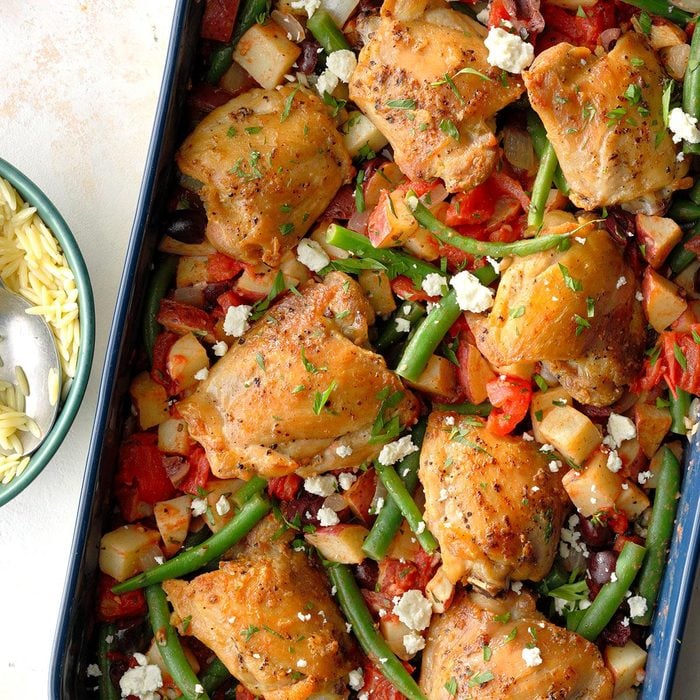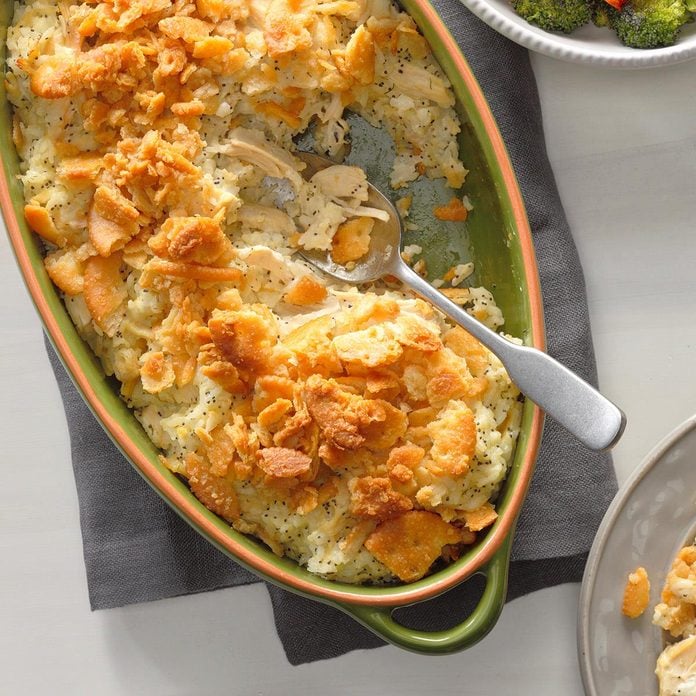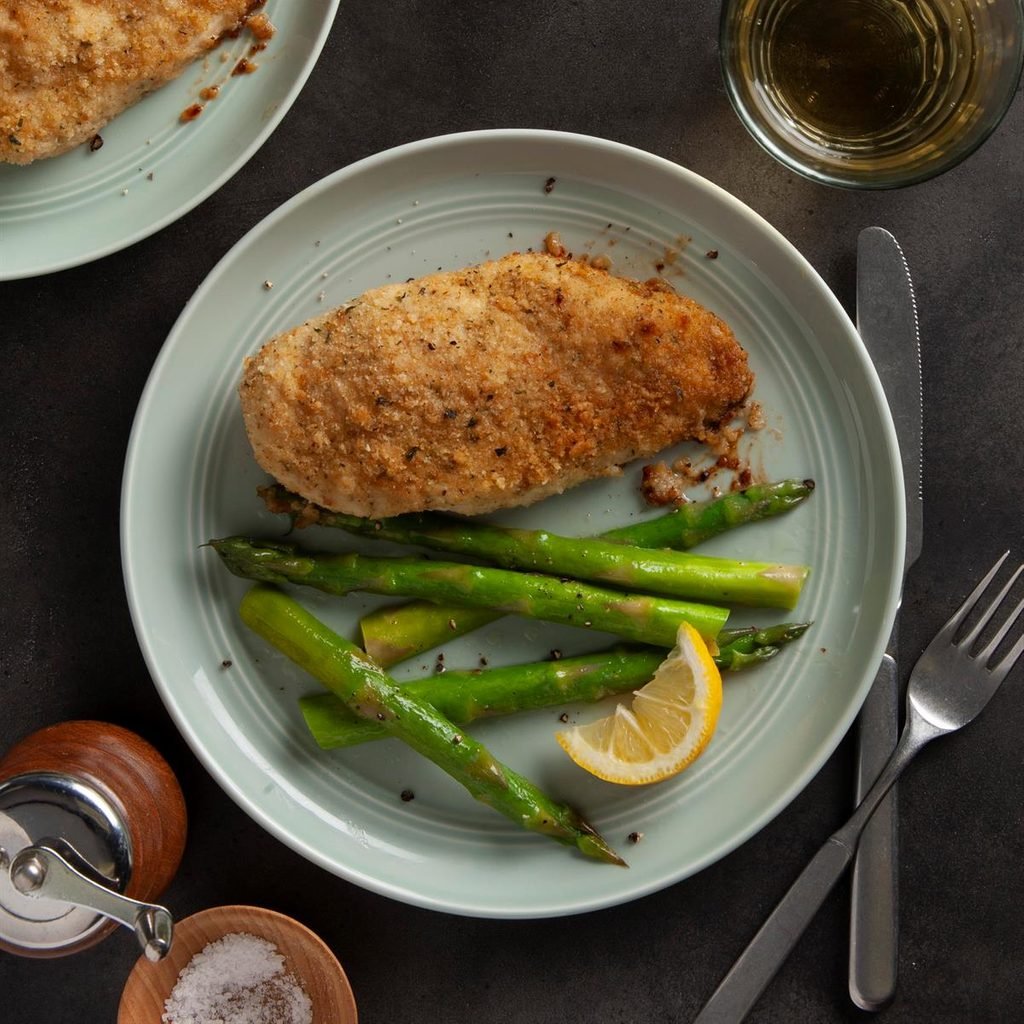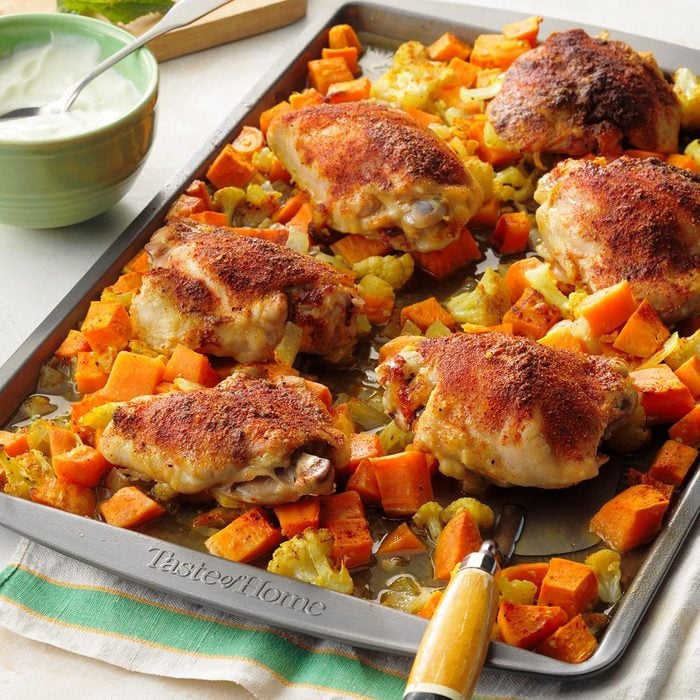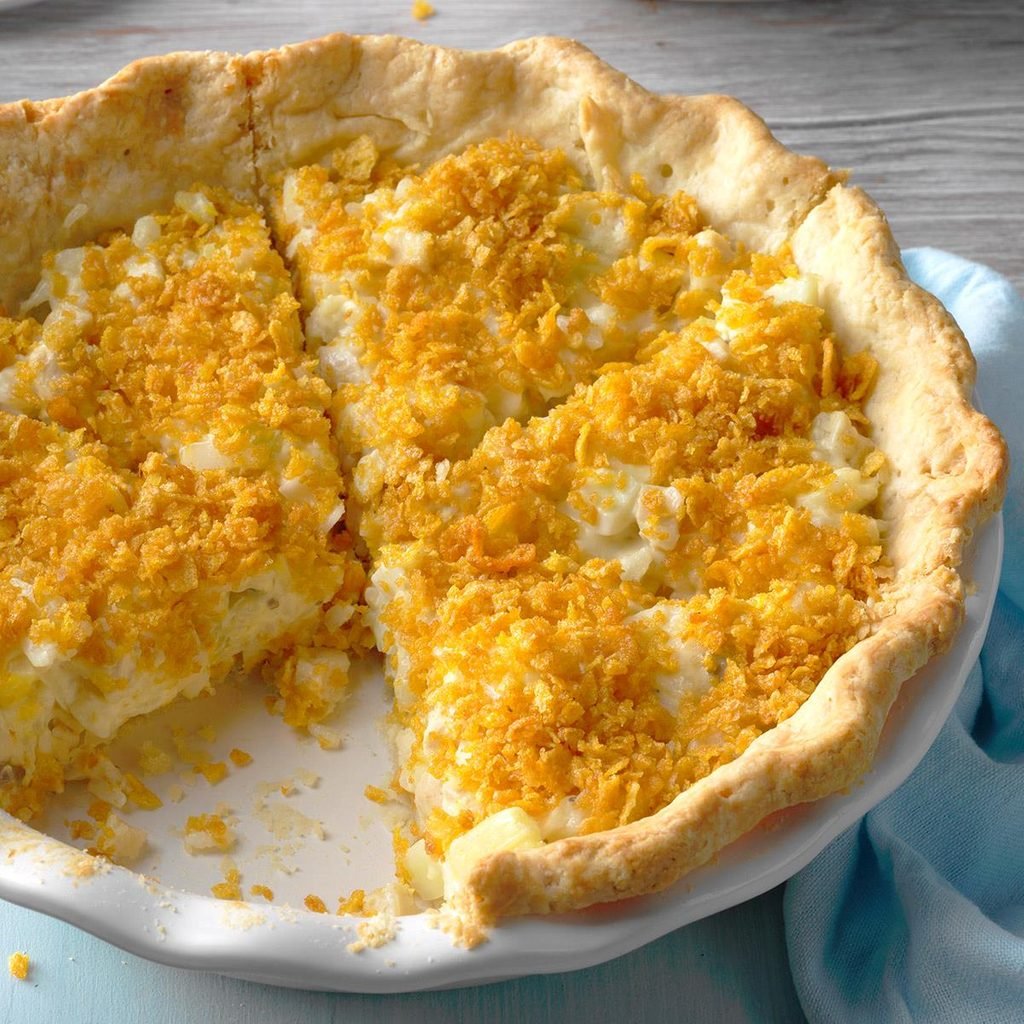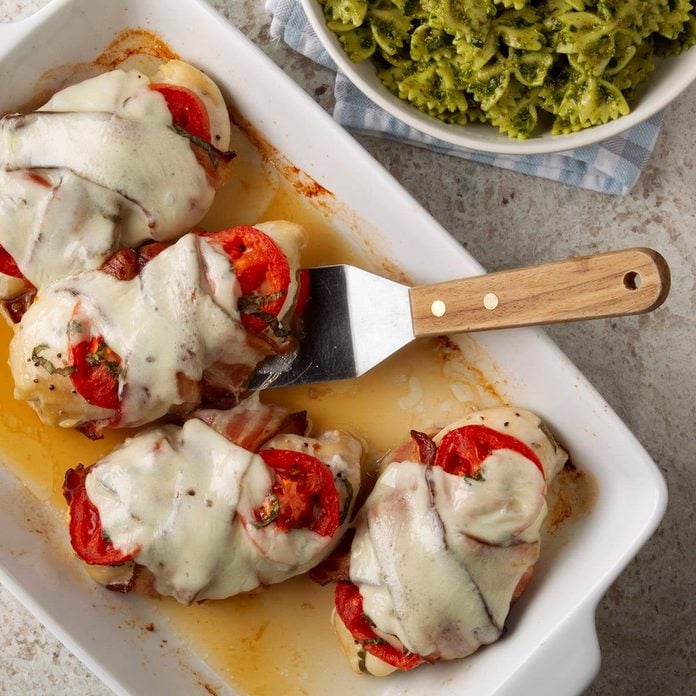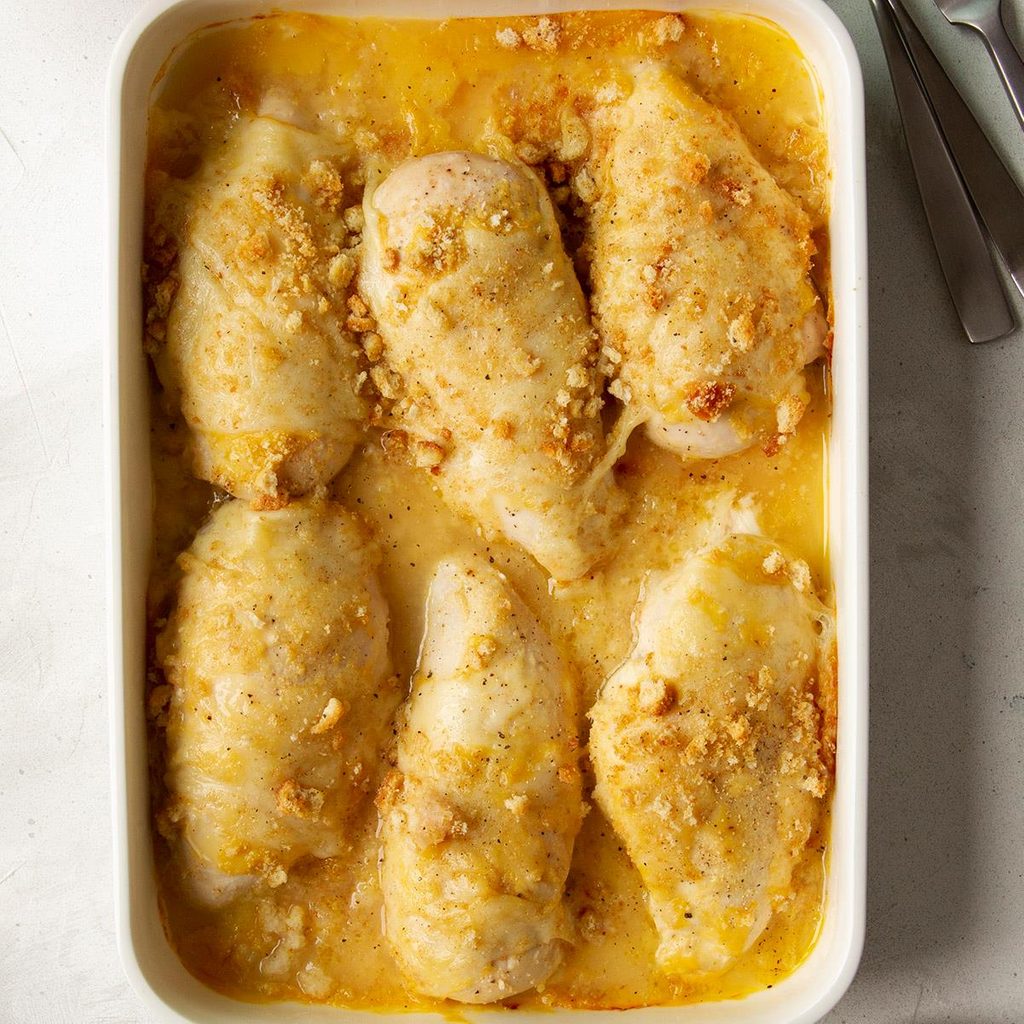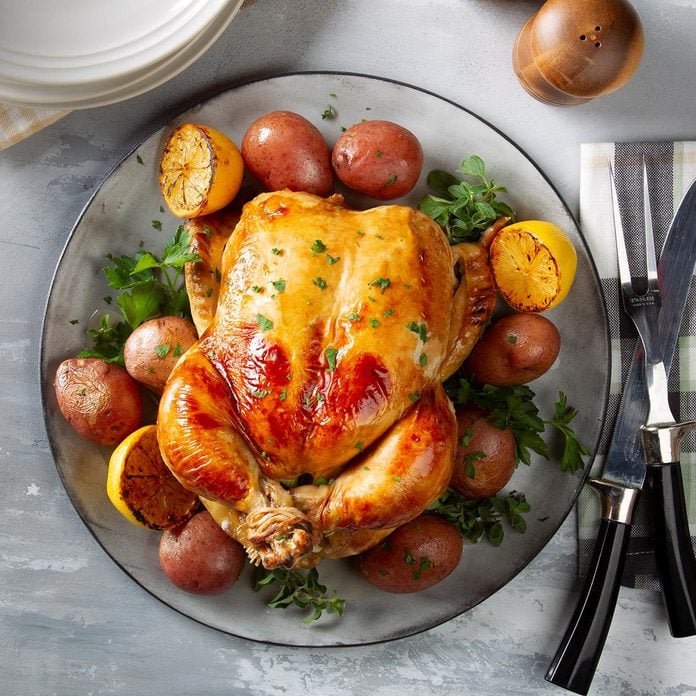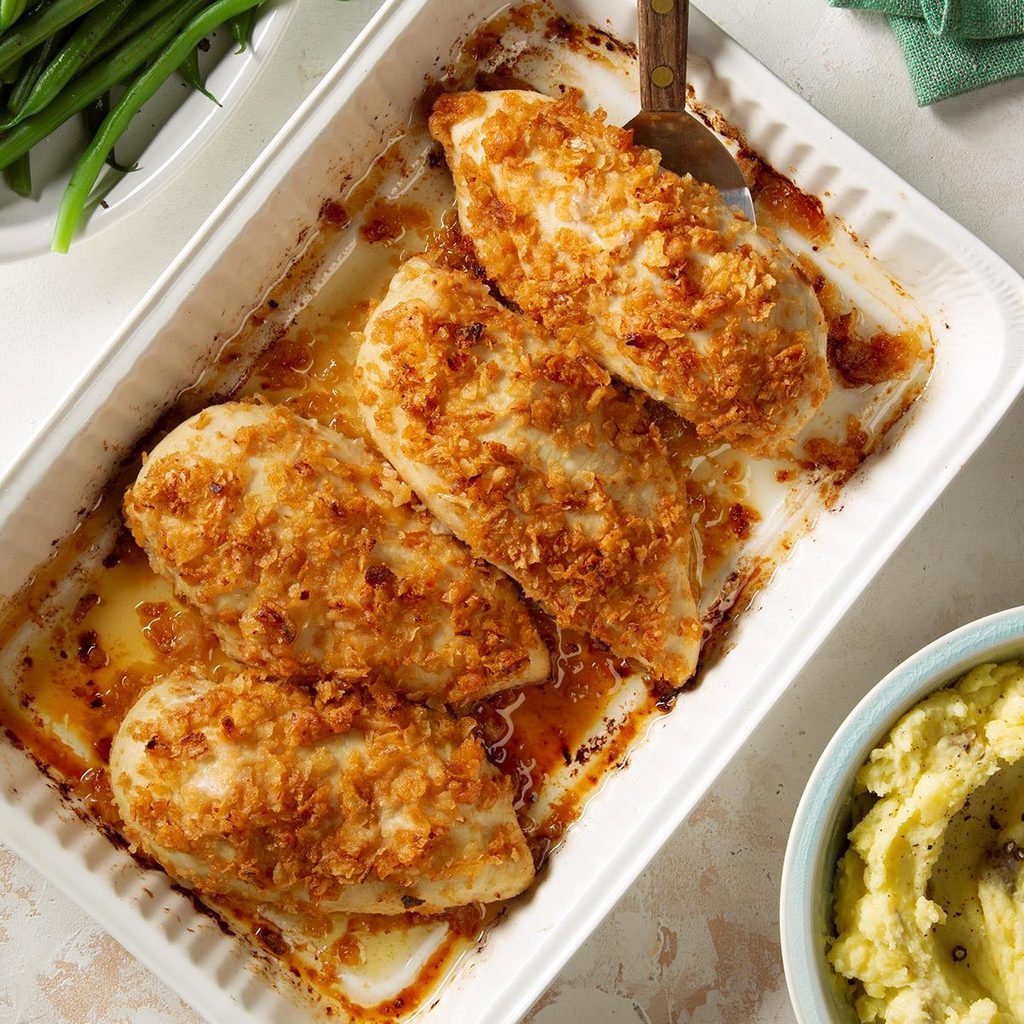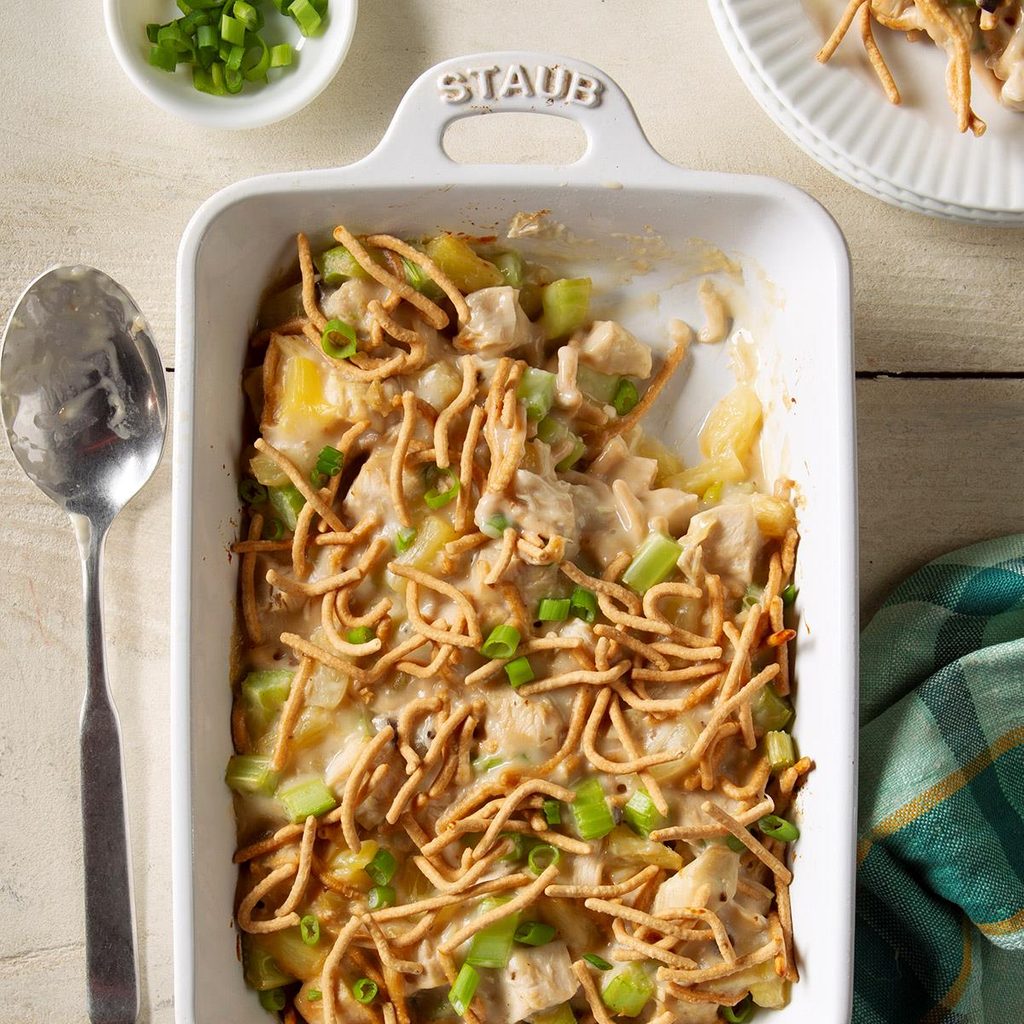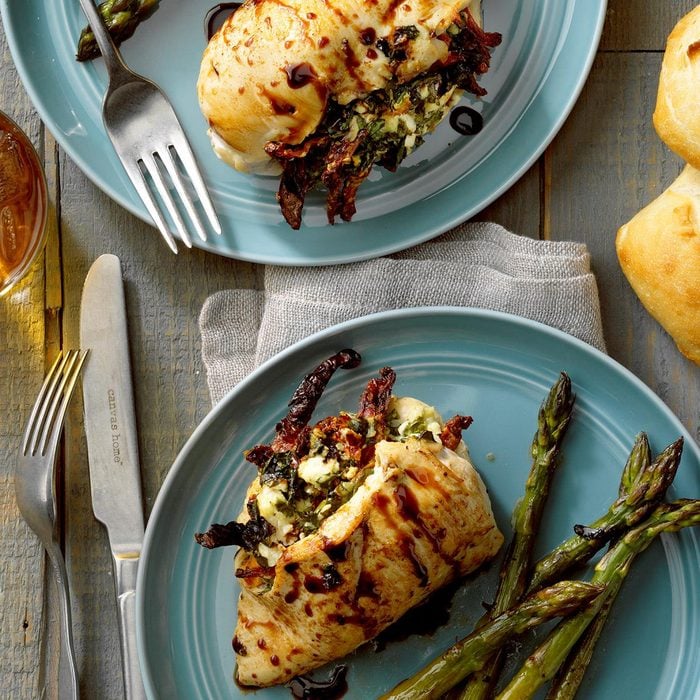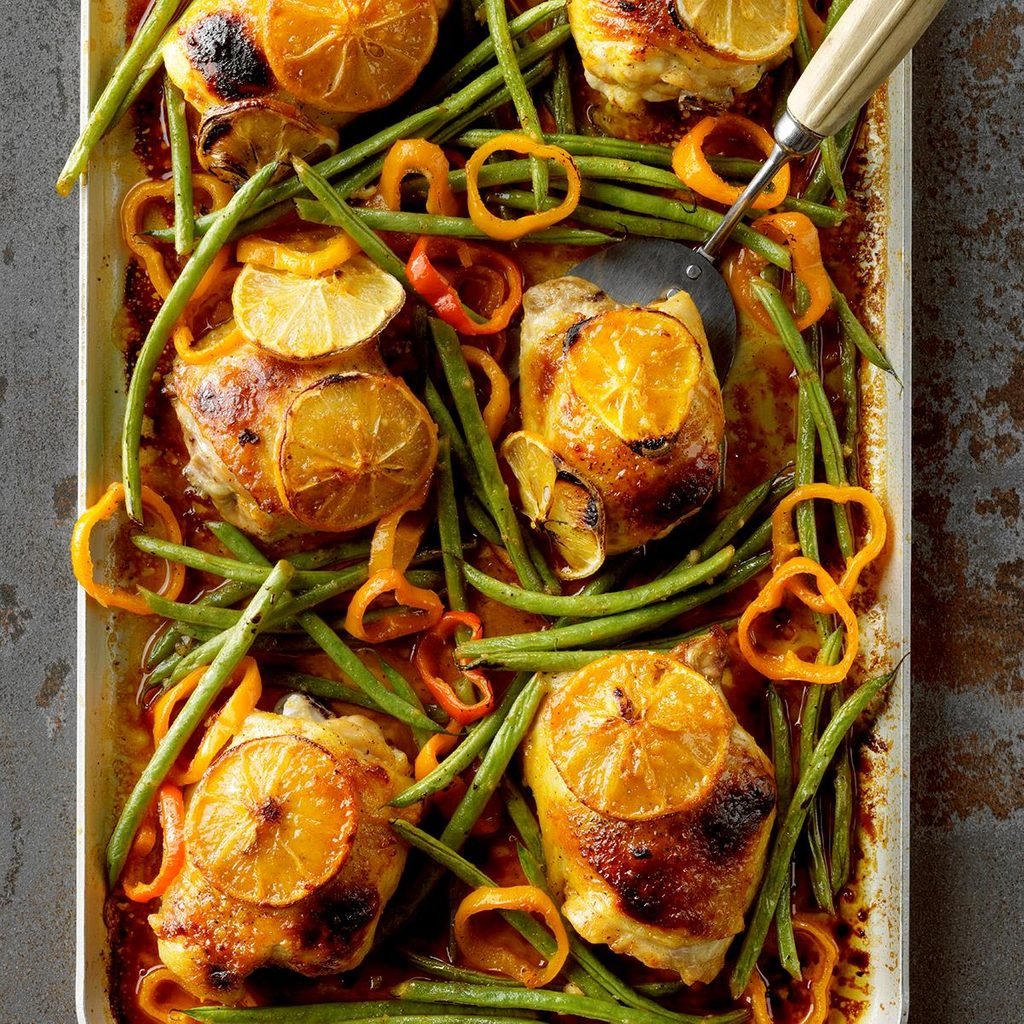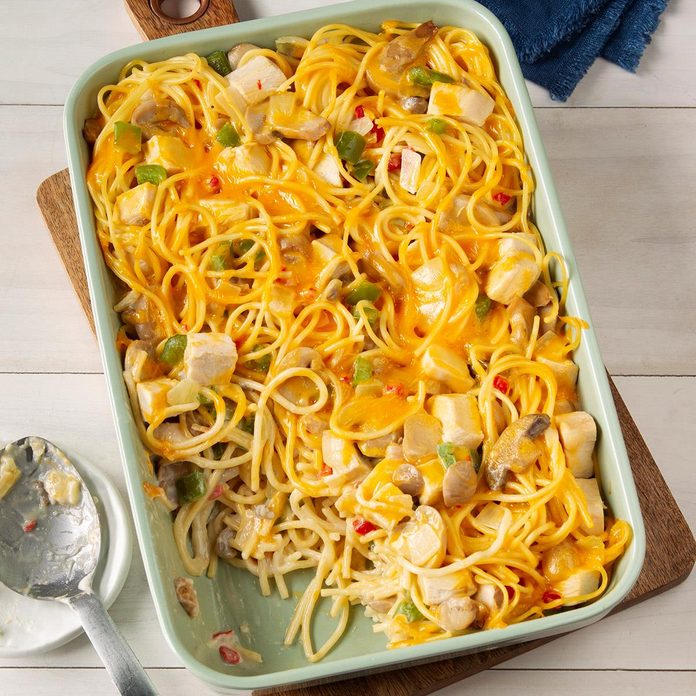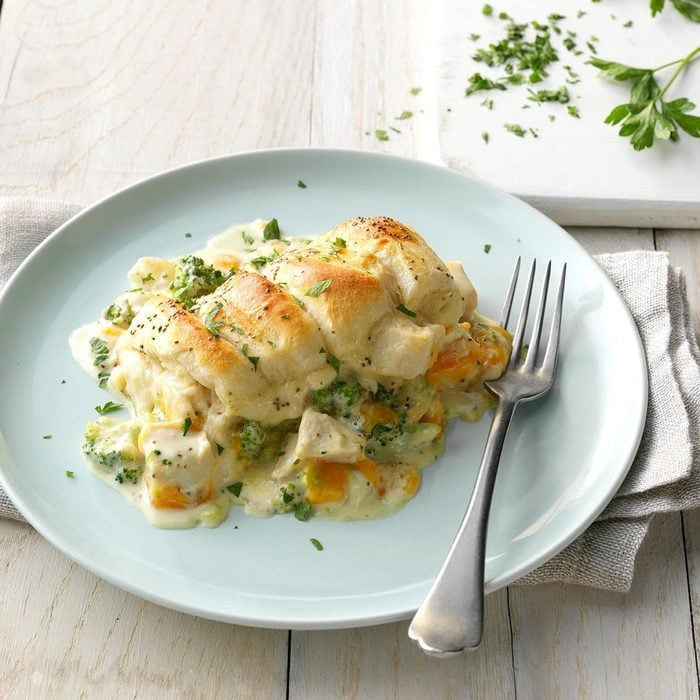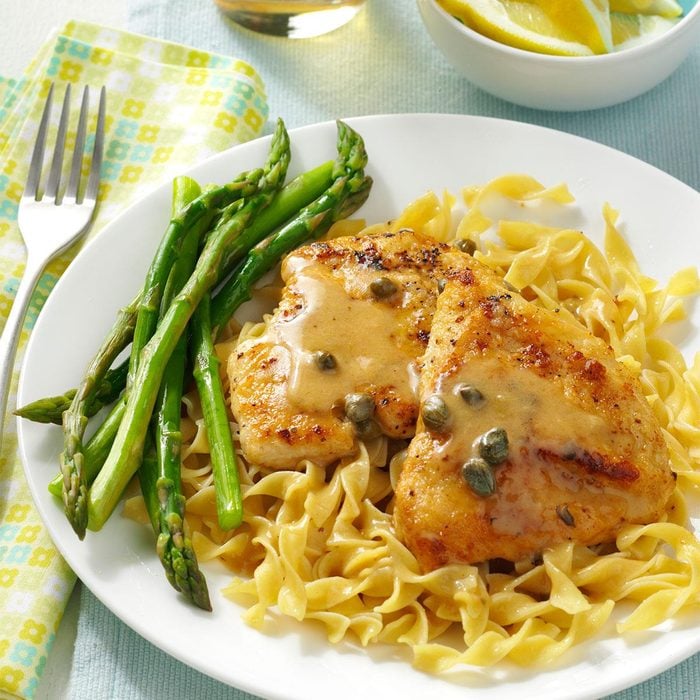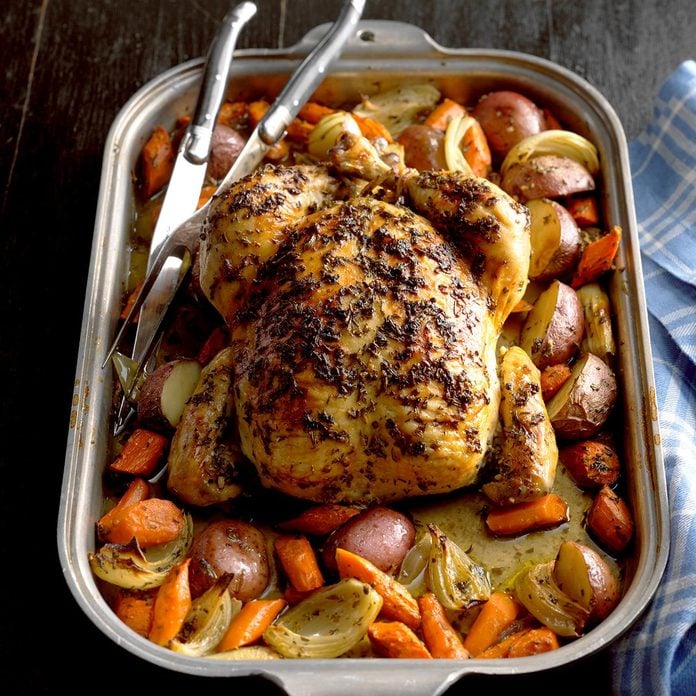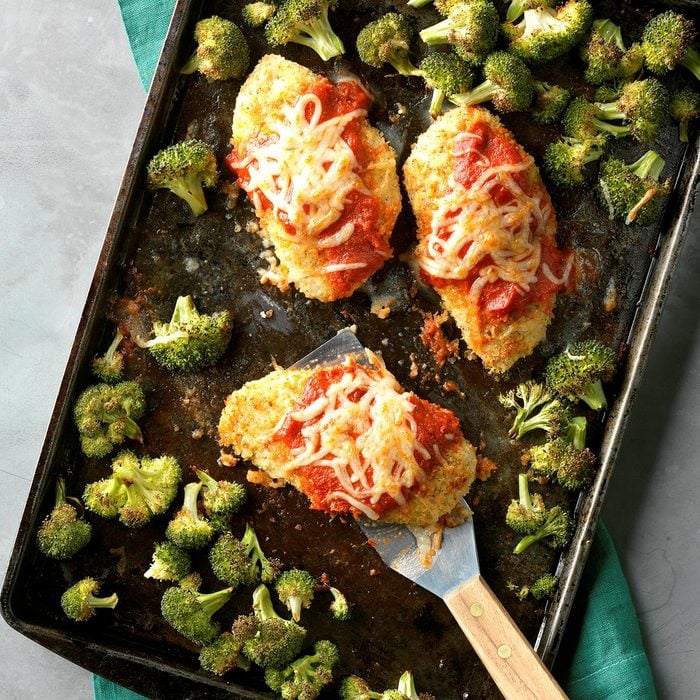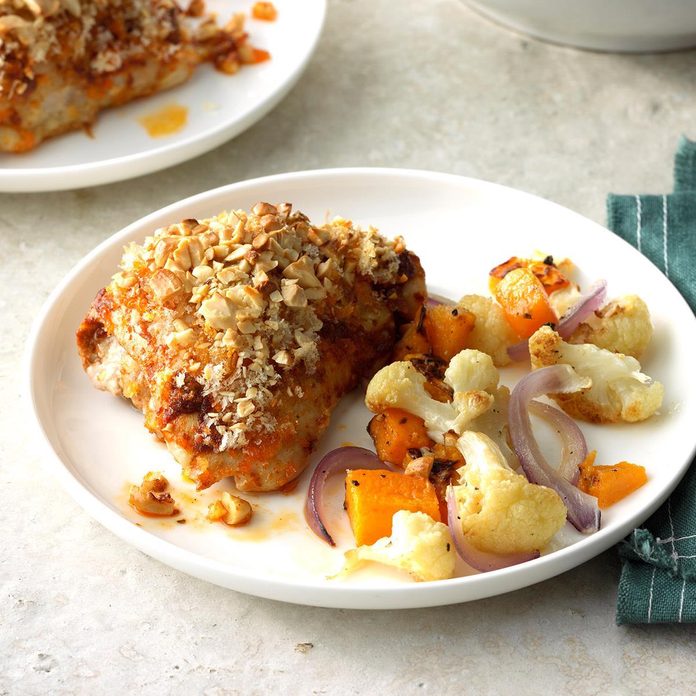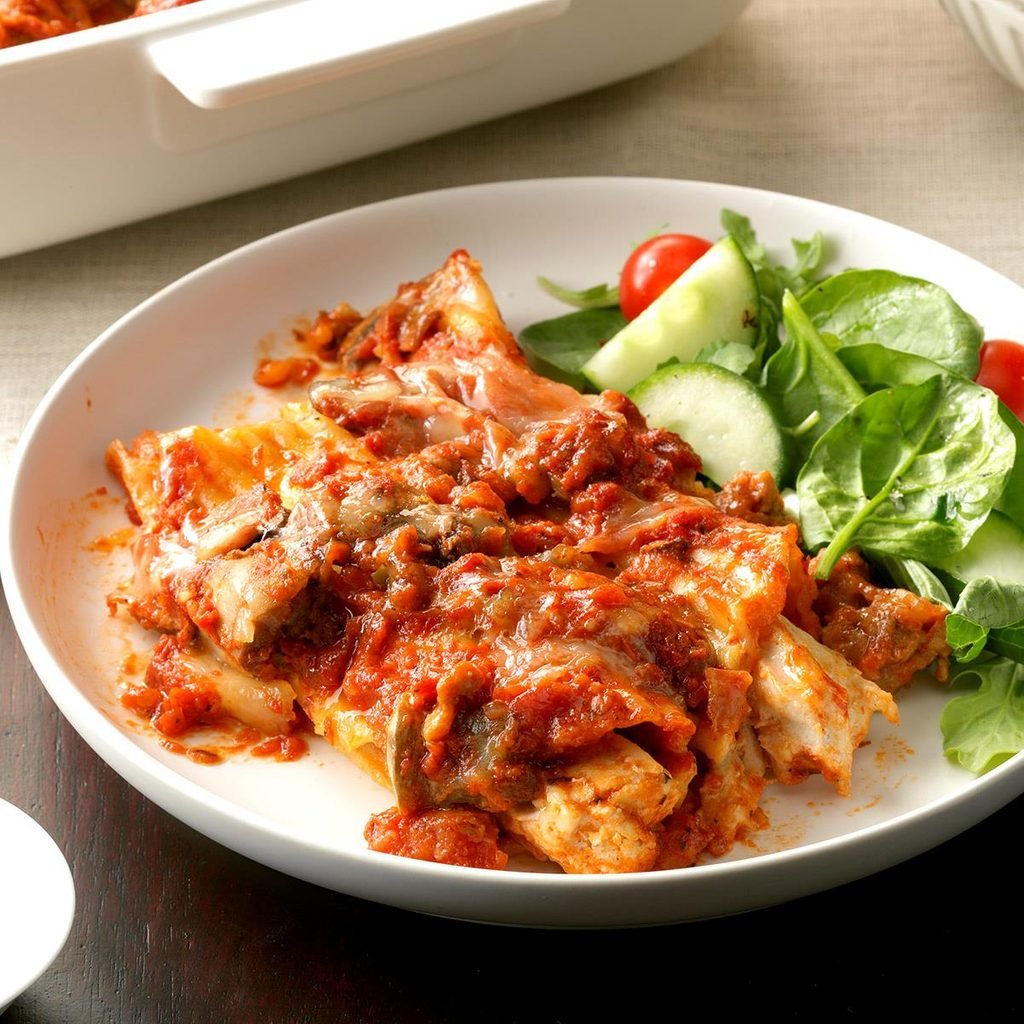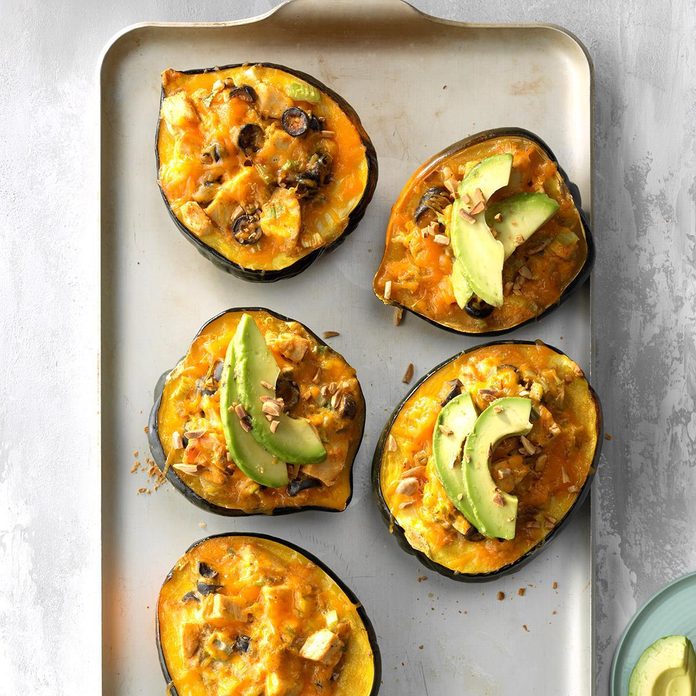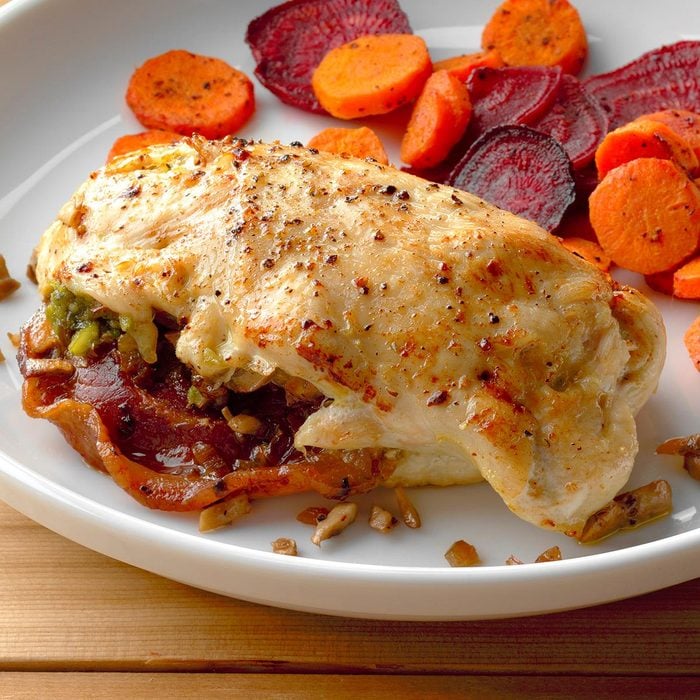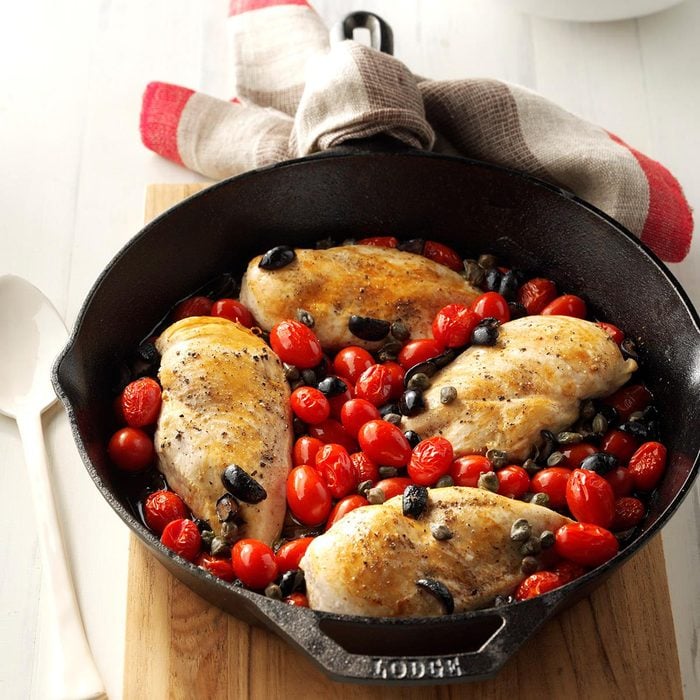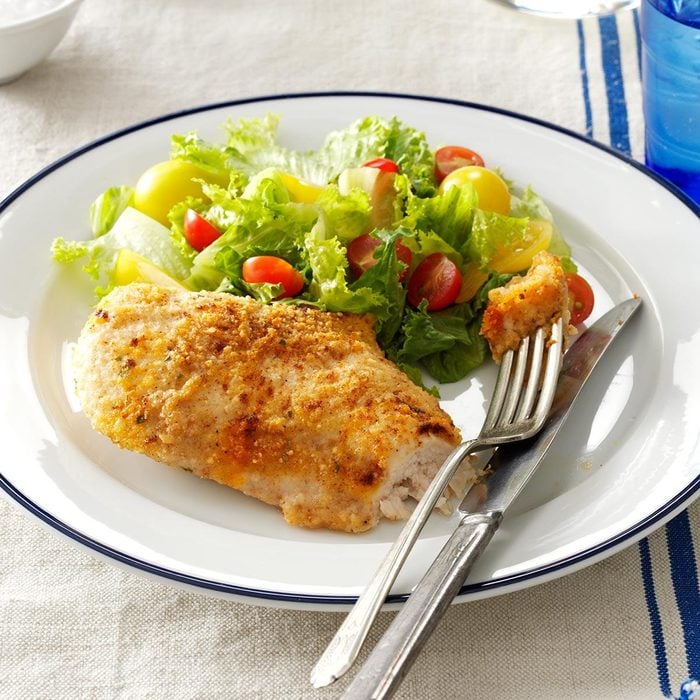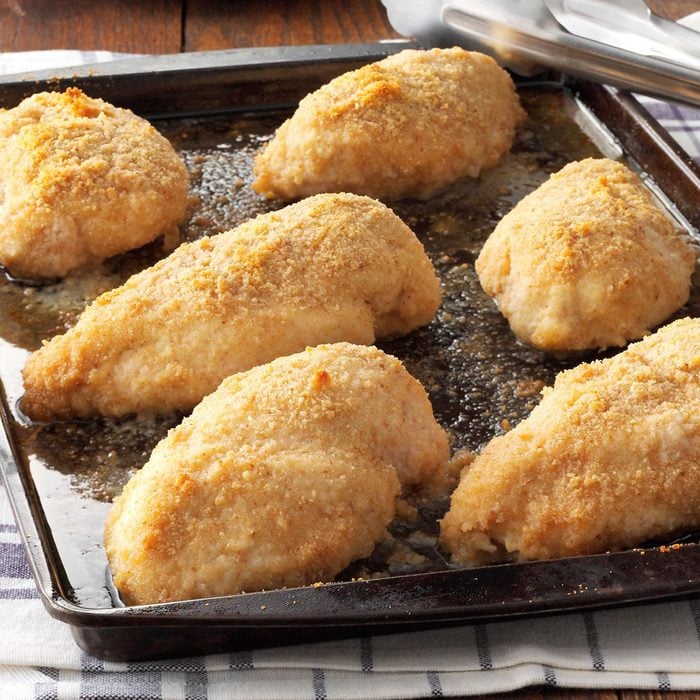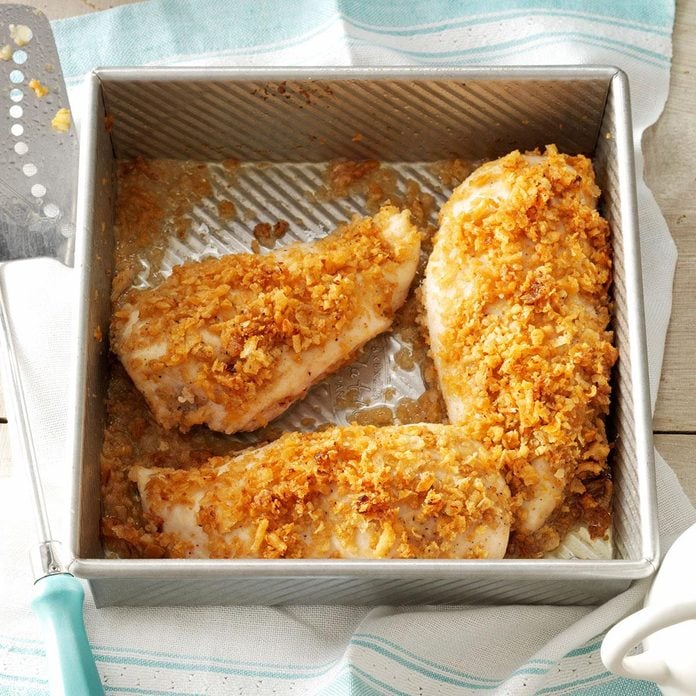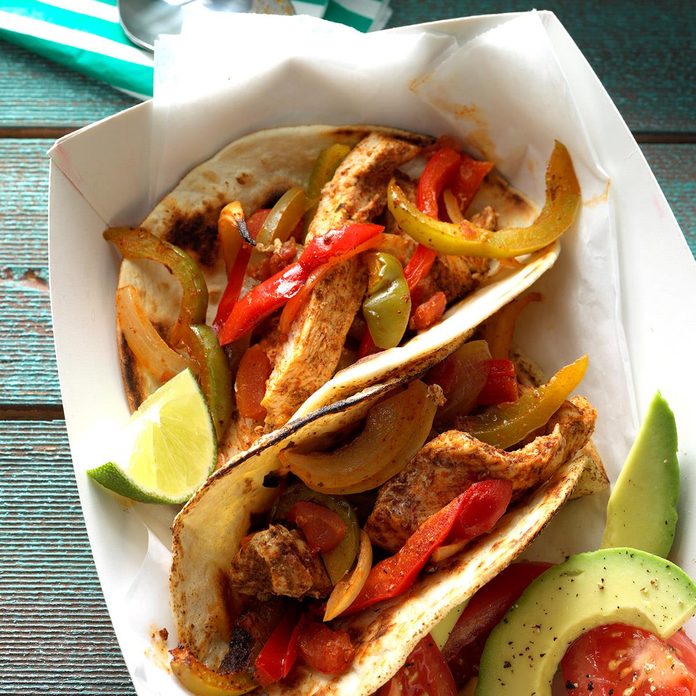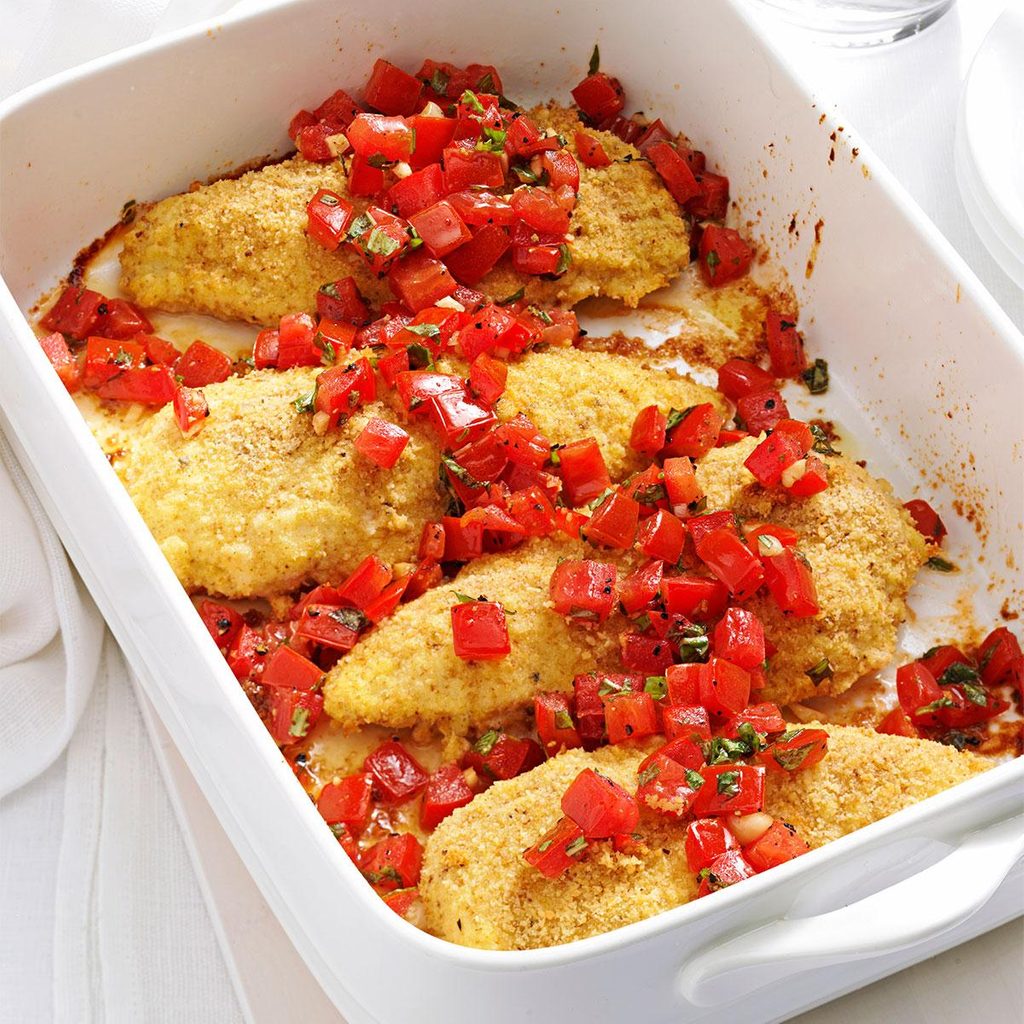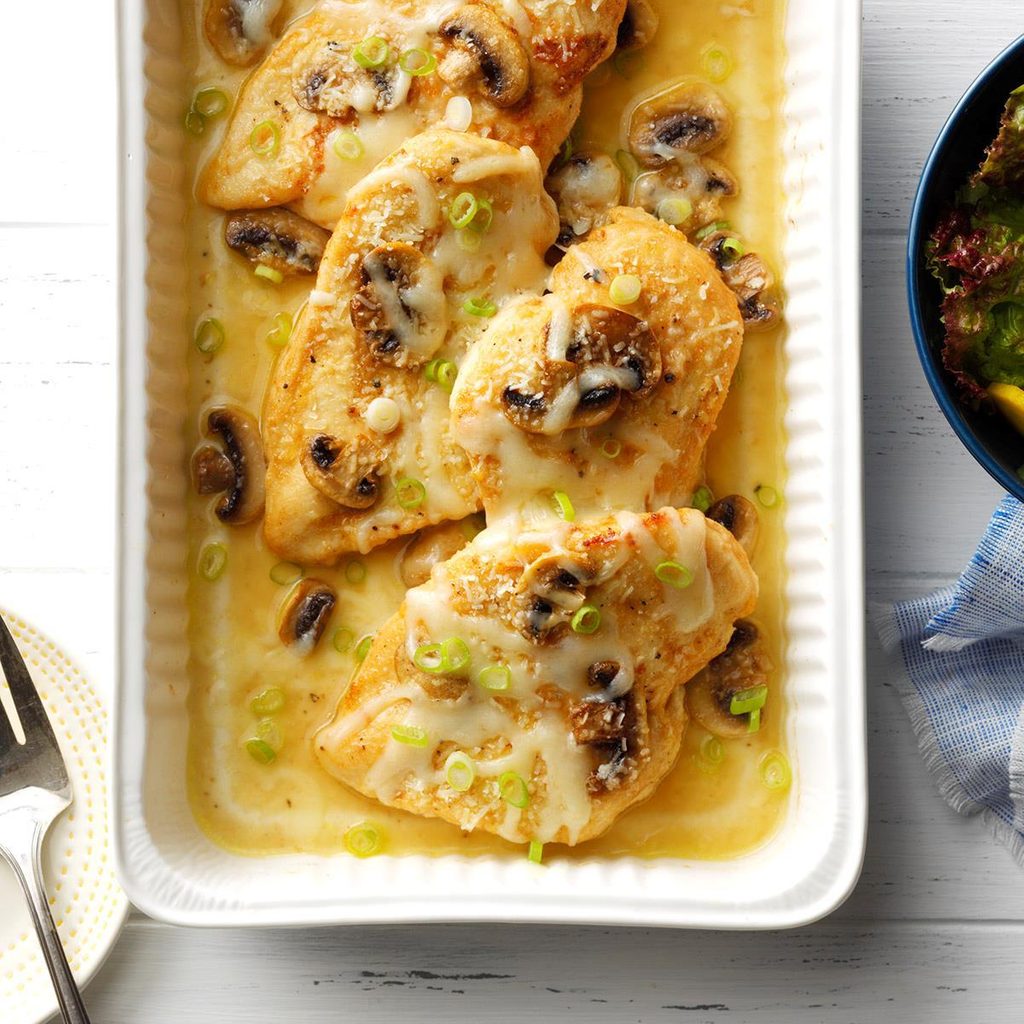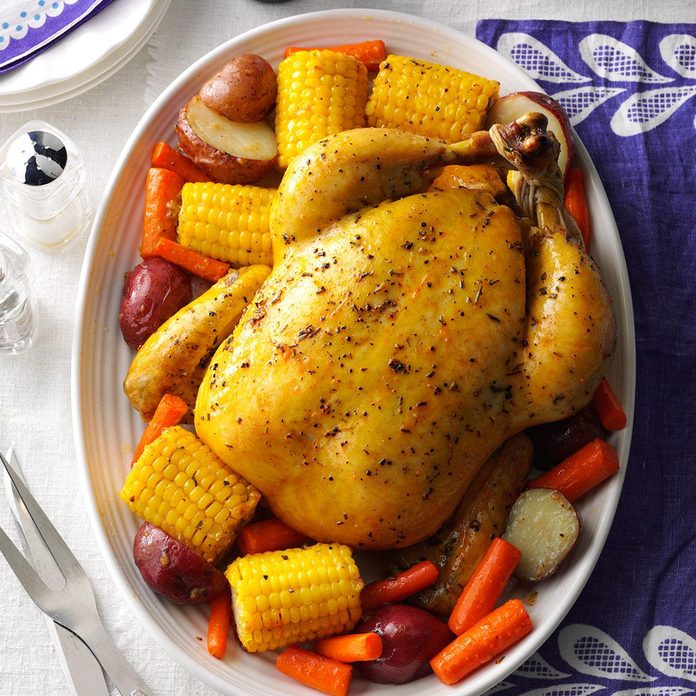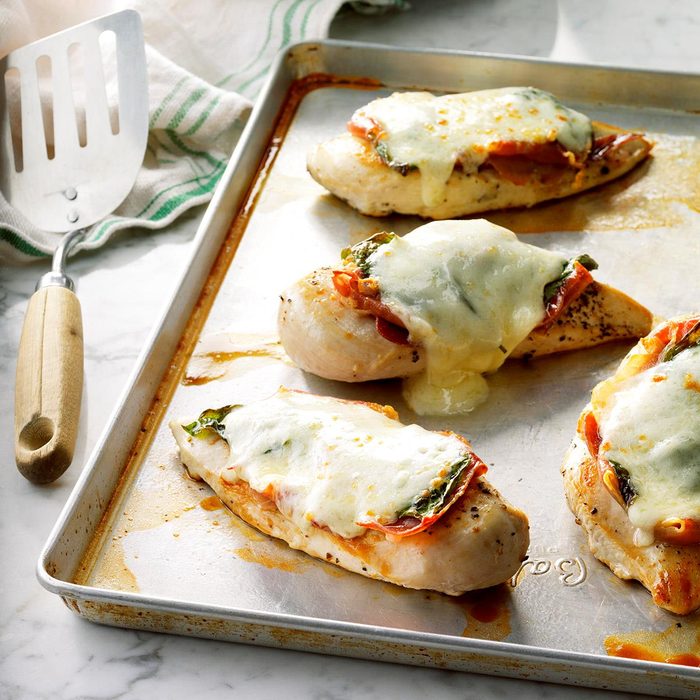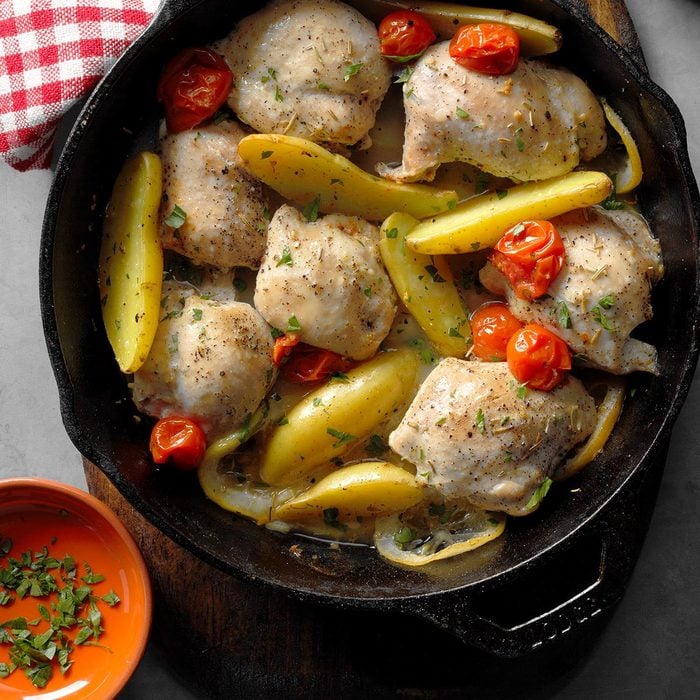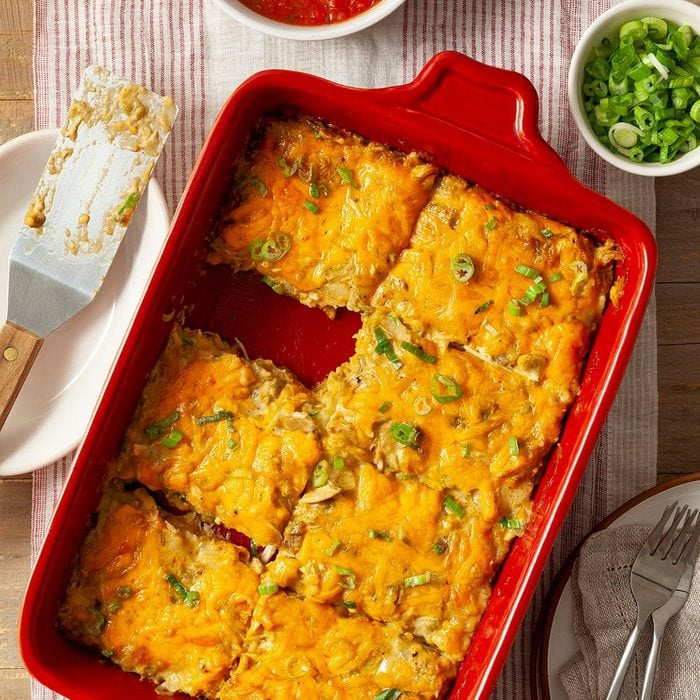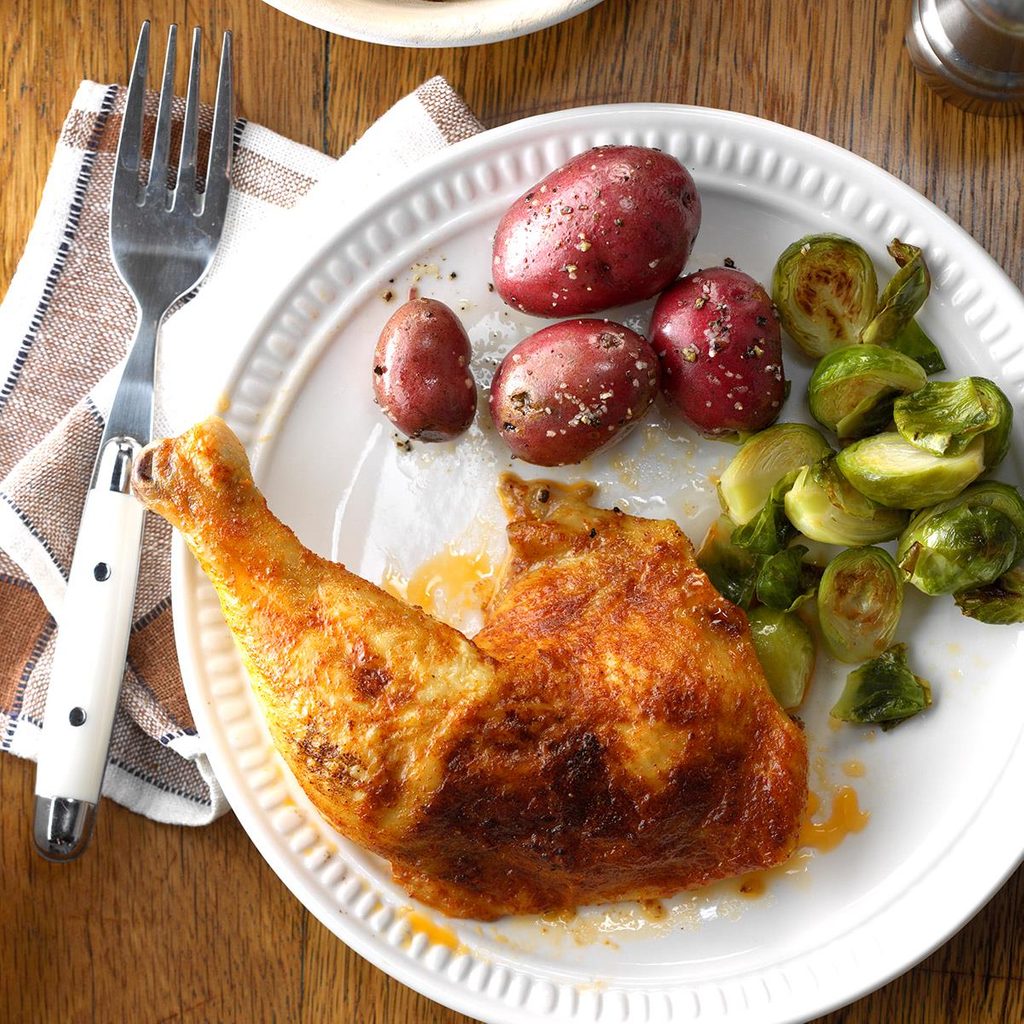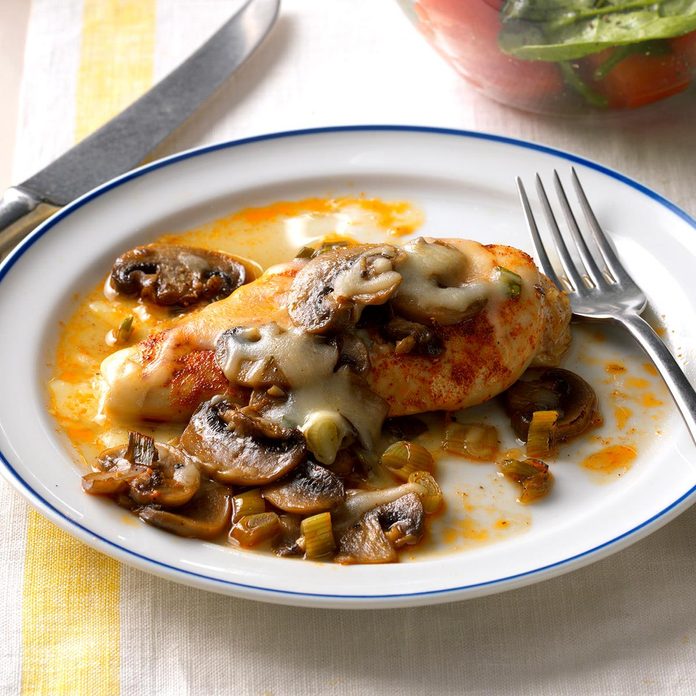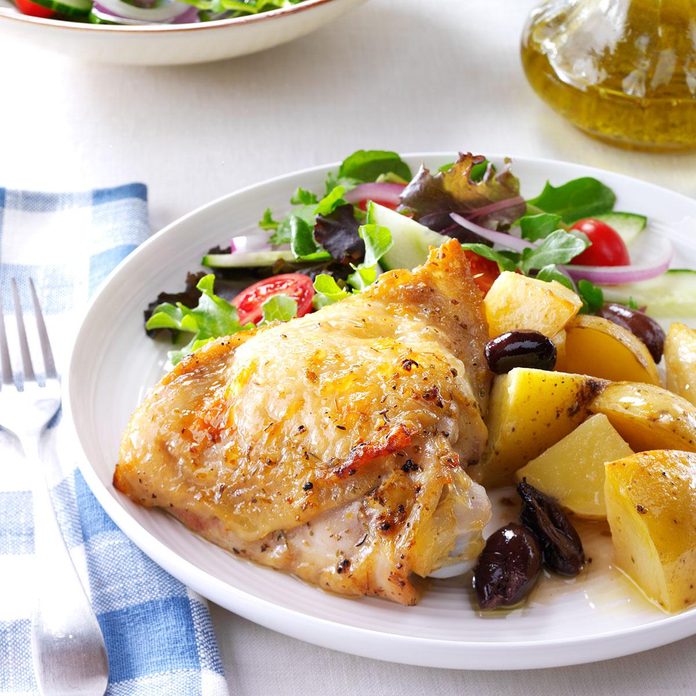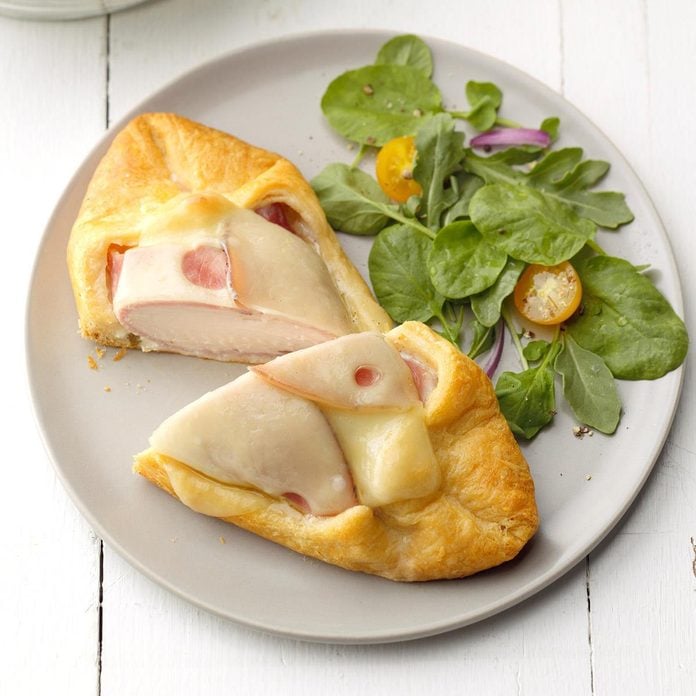In culinary school, times and food-safe temperatures were drilled into our heads. How long can cooked food remain unrefrigerated before it become unsafe? What are the conditions where you can defrost a chicken in water instead of the refrigerator? What’s the maximum amount of time that food can remain between 41° and 135°F? The one that was repeated the most often was the proper temperature of cooked chicken. I remember one of my instructors telling us that, as chefs, we basically had a license to kill. We could cause serious damage by serving bad chicken or undercooked chicken, especially when serving at-risk populations (like children, adults over 65 and anyone with a compromised immune system). Dramatic, sure, but it scared me enough to memorize the number 165°.
According to the USDA, 165° is the temperature that destroys bacteria like salmonella and E. coli. But some chicken recipes call for cooking chicken to 175°, and I’ve seen store-bought packages that say to cook chicken to 185°. So what’s the real answer for the correct temperature of cooked chicken? It really depends on what type of chicken you’re cooking.
How to Take the Internal Temperature of Chicken
The best way to take the internal temperature of chicken is with an instant-read thermometer. In general, you want to probe the chicken in the thickest part of the meat. Make sure the thermometer isn’t touching bone or a pocket of air or fat, which can give you a faulty reading. If you insert the thermometer into the locations listed below and pull it back a quarter inch, the reading should remain the same. If the reading jumps between those two locations, you know something is amiss.
These temperatures also apply when reheating chicken.
Chicken breast
Push the tip of the thermometer into the thickest part of the breast a little more than halfway through, avoiding the bone if cooking bone-in chicken. Most times, it’s easier to go in through the top, although it’s sometimes better to go in through the side. Use your best judgment based on which presents the thickest part of the chicken breast.
After the temperature stabilizes on the thermometer, slowly pull the probe back until it reaches the center of the chicken. If the lowest temperature reading is 165°, the chicken is done.
Chicken thighs
Push the tip of the thermometer through the thickest part of the thigh towards the meat’s center. There’s a small bone that runs through the center of the thigh, so you’ll want to pull the probe back if you happen to hit it.
When the temperature stabilizes on the thermometer, slowly pull the probe back to see if the temperature changes. If the lowest temperature reading is 175°, the chicken is done. You may want to continue cooking the thigh to as high as 195°, depending on personal preference.
Roast chicken
With a roast chicken, you’ll want to check two temperatures: the thighs and the breasts. Use the locations specified above and continue cooking until both locations reach the appropriate temperature.
Chicken wings and chicken drumsticks
It’s difficult to check the temperature on chicken wings and drumsticks. The goal is to insert a thermometer into the thickest part of the meat without touching bone, but wings don’t contain a lot of meat and drumsticks have a large bone running through the middle.
If you can’t get an accurate reading, you can tell if chicken drumsticks and drumettes are finished cooking by looking at the meat on the skinny side of the leg. The meat should shrink up, and you should be able to see a lot more bone than you could when you started cooking.
Internal Temperature for White Meat Chicken
White meat chicken (found in chicken breasts and chicken thighs) should reach an internal temperature of 165° and remain at that temperature for at least 30 seconds. Exceeding this temperature can result in dry, chewy chicken.
Because white meat chicken is so lean, it’s best to cook it at hot temperatures. Chicken breasts roasted in a 450° oven tend to turn out juicier than those cooked in a 350° oven.
Internal Temperature for Dark Meat Chicken
Dark meat chicken (found in chicken drumsticks and chicken thighs) is technically good to eat at 165°, but it’s better to reach a minimum internal temperature of 175° or higher (I generally take my chicken drumsticks closer to 190° to reach the perfect level of tenderness). This type of chicken has more connective tissue than white meat chicken, so it needs higher temperatures to break down. It’s similar to lean beef tenderloin versus fatty beef brisket: Beef tenderloin tastes great at rare or medium-rare temperature, but beef brisket needs to reach 195° to 200° to become tender.
Using lower, slower cooking methods is best for dark meat chicken. Roast dark meat in a 300° oven, braise it in a flavorful liquid or cook it over indirect heat on the grill.
Cooked Chicken FAQs
How to tell if chicken is cooked without a thermometer
An instant read thermometer is the best way to tell when chicken recipes are done. If you find yourself without one, you can cut into the thickest part of the chicken to view the color. Cooked chicken should be firm, white and opaque, and the juices should run clear as you cut into the meat.
The best meat thermometers to use for checking internal temperature
Look for a digital meat thermometer with quick reading speeds and a thin probe, so you don’t lose too many juices when checking the temperature. Our Test Kitchen’s favorite thermometer is this speedy Thermapen. It reads the temperature in less than a second, so you can test the doneness without keeping the oven open for extended periods.
Does the cooking method matter for chicken temperature?
Whether you’re roasting chicken in the oven, pan-frying, deep-frying, grilling or smoking, internal temperatures all remain the same. White meat should reach an internal temperature of 165° and dark meat 175°. The internal temperature of meat in leftover chicken recipes should still reach 165°.
Is 145° safe for chicken?
According to ThermoWorks, pasteurization of chicken is obtained by reaching 165° or by holding chicken at 145° for 8-1/2 minutes. Both of these methods kill harmful bacteria like salmonella and E. coli. That’s why you may see some sous vide recipes that call for cooking chicken at lower temperatures. That said, you should use the USDA recommended temperature minimum of 165° if you have any concerns about food safety or if you’re feeding an at-risk population.
Is it OK to eat chicken that’s a little pink?
Let’s say you used a thermometer that confirmed your chicken reached a safe temperature. When you cut into the chicken, the meat is a little pink or the juices don’t run clear. Is the chicken still safe to eat? Probably! Color is a good indicator when you don’t have a thermometer, but a chicken’s coloring can be affected by more than just temperature. Hemoglobin, the chicken’s feed, whether the chicken has been previously frozen or bone marrow pigment can all color chicken meat, giving it a pink hue even after cooking.
Our Best Baked Chicken Recipes
Pan-Roasted Chicken and Vegetables
This one-dish roast chicken with vegetables tastes as if it took hours of hands-on time to put together, but the simple ingredients can be prepped in mere minutes. The rosemary gives it a rich flavor, and the meat juices cook the veggies to perfection. It’s unbelievably easy! —Sherri Melotik, Oak Creek, Wisconsin
Go to Recipe
Baked Chicken ParmigianaSpaghetti sauce mix is the secret to the flavorful breading in this chicken parmigiana recipe. Just top juicy chicken breasts with prepared sauce and mozzarella cheese. —Trisha Lange, Appleton, Wisconsin
Chicken Marsala en CrouteI love puff pastry and chicken Marsala, so I decided to combine the two. The result is a very special meal perfect for Sunday dinner or any special occasion. Be sure to keep the puff pastry chilled so it is easier to work with. —Lorraine Russo, Mahwah, New Jersey
Cornflake ChickenI took a recipe off a box of baking mix and altered it to make the prep easier. The result was this moist oven-fried cornflake chicken with a thick golden coating that's a lot crisper than the original. —Angela Capettini, Boynton Beach, Florida
Louisiana ChickenGreen peppers and mint add a surprise to this Louisiana chicken recipe. A roasting bag keeps the chicken moist and flavorful. —Jill Werle, Saskatoon, Saskatchewan
Oven Chicken FingersBaked chicken tenders are golden strips of breaded chicken with two tempting sauces for dipping.
—Mary Peterson, Charlestown, Rhode Island.
Baked Chicken and ZucchiniBecause I love zucchini, this colorful dish is one of my favorites, and I make it often in summer. It's especially good with tomatoes fresh from the garden. —Sheryl Goodnough, Eliot, Maine
Chicken Biscuit PotpieThis hearty meal in one takes just 10 minutes to assemble before you can pop it into the oven. —Dorothy Smith, El Dorado, Arkansas
Greek Chicken BakeAs soon as the weather turns cold, I know it's time to pull out this go-to recipe. I assemble it in the morning, then put it in the oven just before dinner. —Kelly Maxwell, Plainfield, Illinois
Poppy Seed Chicken CasseroleThis wholesome poppy seed chicken casserole recipe comes together in under an hour and features nothing but nourishing ingredients, such as condensed cream of chicken soup, sour cream, cooked cubed chicken and rice.
Lemon Chicken BakeThis lovely lemon chicken bake is moist, tender and lemony with a nice crunch. It's a delicious picnic entree as well as a wonderful meal with scalloped or baked potatoes and a fresh green salad on the side. —Marion Lowery, Medford, Oregon
Sheet-Pan Chicken Curry DinnerThis sheet-pan chicken curry is a quick way to get a meal on the table without fuss. Everyone loves it, and it's healthy to boot! Serve it with a side of jasmine rice. —Trisha Kruse, Eagle, Idaho
Hot Chicken Salad PiesThese hot chicken salad pies come together in a snap! They're perfect for when you have leftovers on hand and need to use them up. —Shirley Gudenschwager, Orchard, Nebraska
Caprese Chicken with BaconSmoky bacon, fresh basil, ripe tomatoes and gooey mozzarella top these appealing chicken breasts. —Tammy Hayden, Quincy, Michigan
Baked Chicken ChimichangasI developed this quick and easy recipe through trial and error. I used to garnish it with sour cream, too, but I eliminated it in order to lighten the recipe. My friends all love it when I cook these chimichangas, and they're much healthier than deep-fried. —Rickey Madden, Clinton, South Carolina
Baked Swiss ChickenCanned soup, white wine, Swiss cheese and crushed croutons dress up the chicken breasts in this elegant entree. Ideal for unexpected guests, it requires only a few ingredients. The creamy sauce is excellent with garlic mashed potatoes or rice. —Beverly Roberge, Bristol, Connecticut
Dutch Oven Whole ChickenHere is why a Dutch oven chicken is the easiest, juiciest roast chicken ever.
Tasty Onion ChickenThe secret to this French onion chicken is the yummy, crunchy coating that keeps the meat juicy and tender. Round out your meal with green beans and buttermilk biscuits. —Jennifer Hoeft, Thorndale, Texas
Pineapple Chicken CasseroleI'm always looking for one-dish dinners like this Hawaiian
chicken casserole that save time and cleanup. I love to cook, but with teaching school, playing handbells at church, and juggling my husband's and teen twins' schedules, I have little time in the kitchen. —Susan Warren, North Manchester, Indiana
Goat Cheese and Spinach Stuffed ChickenThis spinach-stuffed chicken breast recipe is special to me because it has so much flavor, yet not too many calories. I love Italian food, but most of the time it is too heavy. This is a healthy twist on an Italian dish! —Nicole Stevens, Mount Pleasant, South Carolina
Sheet-Pan Honey Mustard ChickenThis sheet-pan chicken is an easy gluten-free, low-carb meal ideal for busy weekdays. The chicken is tender, juicy and so delicious! It's now on the list of our favorite meals. You can substitute any low-carb vegetable for green beans. —Denise Browning, San Antonio, Texas
Easy Chicken TetrazziniThis easy chicken tetrazzini is made with leftover cooked chicken and canned soup. It's the perfect recipe for busy weeknights because it's so easy to assemble. Once you pop the dish in the oven, you'll have time to take care of other things on your to-do list. —Martha Sue Stroud, Clarksville, Texas
Chicken Biscuit CasseroleGolden biscuits cover this homespun dish laden with chicken, broccoli and cheese. It's then topped with a celery seed mixture. My family requests this all-in-one dinner once a month. —Karen Weirick, Bourbon, Indiana
Texan Ranch Chicken CasseroleEvery time I serve this creamy chicken ranch casserole, it gets rave reviews. The recipe was passed down to me and is so good! It's really easy to make, freezes well and has just a touch of heat. If your family likes more, add some jalapenos! —Kendra Doss, Smithville, Missouri
Easy Chicken PiccataEasy chicken recipes are my go-to dinner choice. My chicken piccata pasta dish is ready to serve in a half hour. It takes just a few minutes in the oven to bake to tender perfection. —Hannah Williams, Malibu, California
Chicken & Dumpling CasseroleThis savory casserole is one of my husband's favorites. He loves the fluffy dumplings with plenty of gravy poured over them. The basil adds just the right touch of flavor and makes the whole house smell so good while this dish cooks. —Sue Mackey, Galesburg, Illinois
Roasted Chicken with RosemaryHerbs, garlic and butter give this hearty meal in one a classic flavor. It's a lot like pot roast, except it uses chicken instead of beef. —Isabel Zienkosky, Salt Lake City, Utah
Sheet-Pan Chicken ParmesanSaucy chicken, melty mozzarella and crisp-tender broccoli—all in one pan. What could be better? —Becky Hardin, St. Peters, Missouri
Deviled Chicken ThighsI make this dish when I invite my next-door neighbor over for supper. It's just enough for the two of us. The tasty chicken is tender and moist with a bit of crunch from the cashews. —Bernice Morris, Marshfield, Missouri
Chicken ManicottiWhen one of my friends came home from the hospital with her newborn, I sent over this freezer casserole. She and her family raved over how good it was. Try substituting olives for mushrooms or using veal instead of chicken. —Jamie Valocchi, Mesa, Arizona
Arizona Chicken in Acorn SquashGive stuffed acorn squash a taste of the Southwest with this comforting recipe. We love the crunch of the toasted almonds, heat of green chiles, and creamy texture of avocado. —Martha Sparlin, Albuquerque, New Mexico
Breaded Curry Chicken DrummiesThese drumsticks are crispy with just the right amount of zing to get your mouth watering for more! They are super easy to make and are baked rather than fried so they save on fat but not on flavor. Boneless, skinless chicken breasts or assorted chicken parts can be used instead of all drumsticks. —Lynn Kaufman, Mount Morris, Illinois
Pancetta and Mushroom-Stuffed Chicken BreastI was inspired by a stuffed chicken Marsala dish I had at a restaurant and wanted to come up with my own version using a different flavor profile. —Ashley Laymon, Lititz, Pennsylvania
Mediterranean ChickenAs special as it is simple to prepare, this flavorful skillet creation is dressed in tomatoes, olives and capers. It’s a knockout main dish at my house. —Mary Relyea, Canastota, New York
Garlic Lover's ChickenThe garlic and lemon are great together on this breaded chicken. I've served this several times for special-occasion dinners. —Janice Steinmetz, Somers, Connecticut
Parmesan ChickenThe savory coating on this chicken has the satisfying flavor of Parmesan cheese. It's easy enough to be a family weekday meal yet impressive enough to serve to guests. When I make this baked parmesan crusted chicken for dinner, we never have leftovers. —Schelby Thompson, Camden Wyoming, Delaware
Sage Chicken Cordon BleuIt's nice to surprise the family with special meals like this during the week. I usually double the recipe so we can enjoy leftovers the next day. —Martha Stine, Johnstown, Pennsylvania
Crispy Onion ChickenMy family loves chicken, and I'm always trying new ways to prepare it. This golden-brown chicken with its crunchy french-fried onion coating is great with rice, baked potatoes, macaroni salad or potato salad. —Charlotte Smith, McDonald, Pennsylvania
Baked Chicken FajitasI can't remember when or where I found this oven-baked fajitas recipe, but I've used it nearly every week since. We like it with hot sauce for added spice. —Amy Trinkle, Milwaukee, Wisconsin
Bruschetta ChickenWe enjoy serving this tasty chicken bruschetta to both family and guests. It just might become your new favorite way to use up summer tomatoes and basil. —Carolin Cattoi-Demkiw, Lethbridge, Alberta
Baked Mushroom ChickenThis mushroom chicken bake recipe is the perfect way to dress up a standard weeknight dinner. It's a recipe I can count on to yield tender and flavorful results every time. —Barbara McCalley, Allison Park, Pennsylvania
Roast Chicken with VegetablesLove a moist and tender chicken but not the mess of actually roasting one? Use an oven cooking bag to keep a chicken and veggies easily under control. —Taste of Home Test Kitchen
Chicken ProvoloneChicken Provolone, though one of my simplest dishes, is one of my husband’s favorites. It is easy to prepare and looks fancy served on a dark plate with a garnish of fresh parsley or basil. Add some buttered noodles for an easy side dish. —Dawn Bryant, Thedford, Nebraska
Skillet-Roasted Lemon Chicken with PotatoesThis is a meal I have my students make in our nutrition unit. It has a delicious lemon-herb flavor and is simple to make. —Mindy Rottmund, Lancaster, Pennsylvania
Chicken Tortilla CasseroleChicken tortilla casserole is a favorite comfort food dinner. The lasagna-like recipe is super versatile, too!
Deviled ChickenMy family has always loved this flavorful golden brown chicken. I watch for frequent sales on leg quarters to keep the cost per serving low. —Linda Trammell, Kingston, Missouri
Baked Chicken and MushroomsI made up this dish years ago, and it still remains the family's favorite healthy baked chicken recipes. It's a fast weeknight meal, but the fresh mushrooms and sherry make it special enough for a weekend dinner party. —Lise Prestine of South Bend, Indiana
Greek-Style Lemon-Garlic ChickenI love celebrating my Greek heritage with this super simple and scrumptious
Sunday dinner idea. Prep time is a breeze and the ingredient list is relatively short for such a flavorful one-dish meal. Each time I make this I'm transported back to my ya-ya, who gave me the special honor of squeezing the lemons! —Lisa Renshaw, Kansas City, Missouri
Chicken Cordon Bleu in PastryBaking chicken breasts in a flaky dough makes them turn out moist and delicious every time. This fancy dish is nice to serve family as well as guests. Learn how to make
oven-fried chicken breast.
